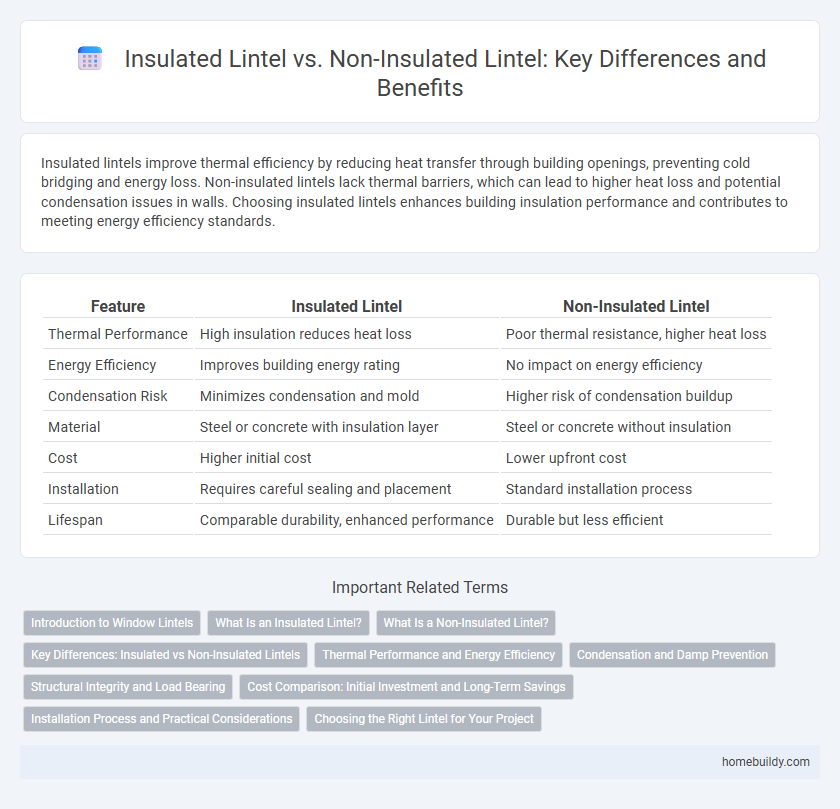Insulated lintels improve thermal efficiency by reducing heat transfer through building openings, preventing cold bridging and energy loss. Non-insulated lintels lack thermal barriers, which can lead to higher heat loss and potential condensation issues in walls. Choosing insulated lintels enhances building insulation performance and contributes to meeting energy efficiency standards.
Table of Comparison
| Feature | Insulated Lintel | Non-Insulated Lintel |
|---|---|---|
| Thermal Performance | High insulation reduces heat loss | Poor thermal resistance, higher heat loss |
| Energy Efficiency | Improves building energy rating | No impact on energy efficiency |
| Condensation Risk | Minimizes condensation and mold | Higher risk of condensation buildup |
| Material | Steel or concrete with insulation layer | Steel or concrete without insulation |
| Cost | Higher initial cost | Lower upfront cost |
| Installation | Requires careful sealing and placement | Standard installation process |
| Lifespan | Comparable durability, enhanced performance | Durable but less efficient |
Introduction to Window Lintels
Window lintels serve as horizontal supports above openings, bearing structural loads and distributing weight around windows. Insulated lintels incorporate thermal breaks or insulating materials to prevent heat loss and reduce thermal bridging, enhancing energy efficiency. Non-insulated lintels lack these features, potentially leading to increased heat transfer and reduced thermal performance in building envelopes.
What Is an Insulated Lintel?
An insulated lintel is a structural beam placed above windows or doors, integrated with thermal insulation to reduce heat transfer and improve energy efficiency. Unlike non-insulated lintels, which are typically made of concrete or steel without thermal barriers, insulated lintels prevent thermal bridging and minimize heat loss. These lintels enhance building performance by maintaining consistent indoor temperatures and meeting modern energy codes.
What Is a Non-Insulated Lintel?
A non-insulated lintel is a structural horizontal support installed above windows or doors, typically made from steel, concrete, or masonry, without any built-in thermal insulation. These lintels primarily bear the load of the wall above the opening but do not prevent heat transfer, leading to potential thermal bridging and energy loss. Choosing non-insulated lintels requires additional insulation measures to maintain building energy efficiency and meet modern thermal performance standards.
Key Differences: Insulated vs Non-Insulated Lintels
Insulated window lintels incorporate thermal breaks or insulation materials within their structure, significantly reducing heat transfer and enhancing energy efficiency compared to non-insulated lintels. Non-insulated lintels, typically made of steel or concrete without thermal barriers, can create thermal bridges that lead to heat loss and potential condensation issues. Choosing insulated lintels improves building thermal performance, lowers energy costs, and helps meet stringent building codes for energy efficiency.
Thermal Performance and Energy Efficiency
Insulated window lintels significantly enhance thermal performance by reducing heat transfer through the building envelope, leading to improved energy efficiency and lower heating and cooling costs. Non-insulated lintels allow thermal bridging, resulting in increased heat loss and higher energy consumption. Incorporating insulated lintels in construction minimizes cold spots and condensation risks, contributing to better indoor comfort and sustainable building practices.
Condensation and Damp Prevention
Insulated window lintels significantly reduce the risk of condensation by maintaining a consistent thermal barrier, preventing cold spots where moisture can accumulate. Non-insulated lintels often lead to thermal bridging, causing surface temperatures to drop and increasing the likelihood of dampness and mold growth. Effective condensation and damp prevention are critical for structural integrity and indoor air quality, making insulated lintels a superior choice in modern construction.
Structural Integrity and Load Bearing
Insulated window lintels provide enhanced thermal performance while maintaining comparable structural integrity and load-bearing capacity to non-insulated lintels. Non-insulated lintels primarily focus on strength and support, often made from steel or concrete, without thermal breaks that reduce energy efficiency. Selecting insulated lintels ensures load-bearing reliability and improved building envelope performance, minimizing thermal bridging and potential condensation risk.
Cost Comparison: Initial Investment and Long-Term Savings
Insulated window lintels typically have a higher initial investment compared to non-insulated lintels due to added materials and manufacturing complexity. Over time, insulated lintels contribute to significant energy savings by reducing heat transfer and improving thermal efficiency in building envelopes. Non-insulated lintels may lower upfront costs but often result in increased heating and cooling expenses, impacting long-term savings negatively.
Installation Process and Practical Considerations
Insulated lintels require careful handling during installation to maintain the integrity of the thermal break, often involving additional steps such as precise fitting of insulation layers and sealing to prevent thermal bridging. Non-insulated lintels have a simpler installation process, generally focusing solely on structural support without the need for added insulation materials. Practical considerations for insulated lintels include improved energy efficiency and condensation prevention, whereas non-insulated options may be preferred in applications where cost or installation speed is prioritized.
Choosing the Right Lintel for Your Project
Choosing the right lintel depends on the thermal performance required for your window installation. Insulated lintels provide superior energy efficiency by reducing thermal bridging and enhancing overall insulation, making them ideal for projects targeting high-performance building standards. Non-insulated lintels are typically more cost-effective but may compromise on thermal resistance, suitable for applications where energy efficiency is less critical.
insulated lintel vs non-insulated lintel Infographic

 homebuildy.com
homebuildy.com